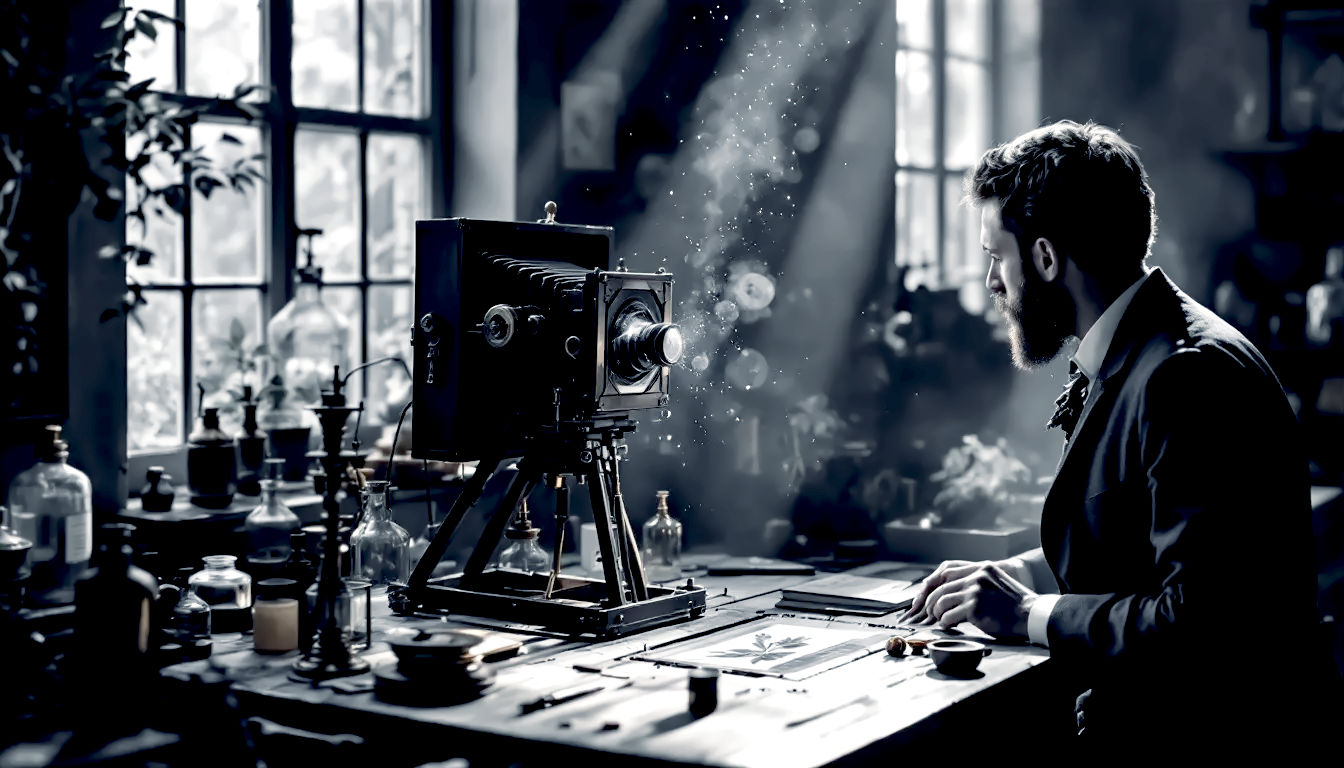From Sun-Catchers to Selfies: The Complete Story of How Photography Was Invented
Explore the definitive history of photography. Meet the inventors, discover the rival processes, and learn how a blurry image from a French window changed the world.

This post may contain affiliate links. If you make a purchase through these links, we may earn a commission at no additional cost to you.
We do it without a thought. Point a phone, tap a screen, and a moment is captured forever. A birthday party, a stunning sunset, a silly face pulled by a mate. We take, share, and store billions of photos every single day. It’s instant, easy, and everywhere.
But have you ever stopped to wonder how we got here? How did humanity learn to trap light and shadow on a surface, to freeze a fleeting second in time? The journey to that first ‘click’ wasn’t a single event but a sprawling, fascinating adventure. It’s a story of clever people, happy accidents, and fierce rivalries, stretching back centuries. It involves artists in dark rooms, French inventors with unpronounceable names, and a rather brilliant British gentleman tinkering away in his country estate.
This is the definitive story of how photography was invented. It’s a tale that didn’t just give us holiday snaps; it fundamentally changed how we see the world, how we remember our past, and how we tell our stories. So, let’s rewind the clock, long before the age of Instagram and smartphones, to a time when capturing an image of reality was nothing short of magic.
Before the Flash: The Two Puzzles of Photography
Before anyone could take a photograph, two huge problems needed to be solved. Think of them as two different locks on a door. You needed both keys to open it.
The first problem was optical. How do you get an image of the real world to appear on a flat surface? The second problem was chemical. Once you’ve got that image, how do you make it stay there permanently?
For centuries, people had the key to the first lock but were completely stumped by the second.
The First Key: The Camera Obscura
Long before cameras, there was the camera obscura, which is Latin for “dark room.” And that’s exactly what it was. Imagine you’re in a room with no windows, and every crack is sealed so it’s pitch black. Now, you poke a tiny pinhole in one wall. A strange and wonderful thing happens. On the opposite wall, a full-colour, upside-down image of the world outside appears.
This wasn’t a new discovery. The basic idea was mentioned by thinkers in ancient China and Greece. By the Renaissance, artists were using portable, box-sized camera obscuras to help them draw. They could trace the projected image to get perspective and detail just right. It was a brilliant tool for drawing, but that’s all it was. The image was there one moment and gone the next. It was like a projection, not a permanent picture.
So, they had the “camera” part, but not the “photography” (which means “drawing with light”). They needed a way to make the light draw the picture itself.
The Second Key: The Chemical Puzzle
The second piece of the puzzle lay in chemistry. For hundreds of years, people had noticed that some substances changed when left in the sun. The most important of these were silver salts, like silver nitrate and silver chloride. In the 1700s, scientists proved that it was light, not heat, that caused these silver compounds to darken.
This was a massive clue. If you could coat a piece of paper with silver salts and project an image onto it with a camera obscura, the bright parts of the image would darken the salts, and the dark parts would leave them white. You’d get a picture!
And people tried it. Around 1800, here in Britain, a man named Thomas Wedgwood (from the famous pottery family) and the brilliant chemist Sir Humphry Davy came agonisingly close. They managed to create faint, shadowy images of leaves and paintings on treated paper and leather. They called them “sun pictures.”
But they hit a brick wall. The moment they took their pictures out into the light to look at them, the whole sheet of paper would go black. They couldn’t figure out how to “fix” the image—how to wash away the unexposed silver salts so the picture would stop developing. Heartbroken, they gave up. The door to photography remained stubbornly locked.
The Breakthrough: Three Men, One Idea
The race to finally invent photography wasn’t an organised competition. It was more like three men, in two different countries, all trying to solve the same puzzle at roughly the same time, without initially knowing about each other. Their work would give us not one, but two distinct ways of creating a photograph.
The First Photograph: Joseph Nicéphore Niépce
The first person to officially succeed—to create a permanent image from nature using a camera—was a French inventor named Joseph Nicéphore Niépce (pronounced Nee-see-for Nee-eps). He wasn’t a chemist or an artist; he was a wealthy, curious gentleman who spent his time on inventions.
He called his process heliography, or “sun drawing.” It was a strange and complicated method.
- He took a polished pewter plate.
- He coated it with a type of asphalt called Bitumen of Judea. This stuff had a weird property: where bright light hit it, it would harden and become insoluble in oil.
- He placed the plate in a camera obscura and pointed it out of his upstairs window at his country estate, Le Gras, in France.
- He then left it. For a very, very long time.
The exposure took at least eight hours, and possibly even several days. The sun slowly crawled across the sky, hardening the bitumen where the light was brightest (like the rooftops and the sky).
After this marathon exposure, Niépce took the plate and washed it with a mixture of lavender oil and white petroleum. The unhardened bitumen in the shadowy areas washed away, leaving the bare pewter. The hardened bitumen in the bright areas stuck to the plate. The result? A very faint, ghostly, but permanent image.
Created around 1826 or 1827, this picture, known as “View from the Window at Le Gras,” is recognised as the world’s first surviving photograph. It’s not much to look at today—a blurry view of rooftops and a pear tree—but it’s one of the most important images in history. It proved that capturing a slice of reality was possible.
However, heliography was a dead end. The exposure times were ridiculously long, and the results were faint and lacked detail. It wasn’t a practical process. But Niépce had opened the door.
Making it Sharp and Shiny: Louis Daguerre
News of Niépce’s work reached another Frenchman, Louis Daguerre (pronounced Da-gair). Daguerre was a showman, an artist who ran a popular Paris attraction called the Diorama, which used huge painted scenes and clever lighting to create illusions. He had also been trying to capture the images from his camera obscura and was fascinated by Niépce’s success.
The two men became partners in 1829, hoping to improve the process together. Sadly, Niépce died a few years later, leaving Daguerre to carry on alone. And carry on he did. Through years of experimentation (and one very lucky accident), he invented a completely new and much better method.
This process, which he modestly named the daguerreotype, was unveiled to a stunned world in 1839. The French government, recognising its importance, bought the rights and generously gave it to the world for free… except, crucially, for Britain, where a patent was taken out.
The daguerreotype process was like something from an alchemist’s workshop:
- You started with a sheet of copper plated with a thin layer of highly polished silver. It had to be polished to a perfect mirror finish.
- You took this plate into a dark box and exposed it to iodine fumes, which made the silver surface light-sensitive.
- You then put the plate in a camera and exposed it to light. Early exposures took around 15 minutes, but this was quickly reduced to under a minute.
- Here’s the clever bit. No image was visible yet! To develop it, you put the plate in another box and exposed it to hot mercury fumes. The mercury would stick to the parts of the plate that had been hit by light, creating a frosty, whitish image.
- Finally, you fixed the image by bathing it in a salt solution (later, the same “hypo” used by Talbot) to make it permanent.
The results were breathtaking. A daguerreotype was incredibly sharp and detailed. People who saw the first ones were amazed; it was like looking at a “mirror with a memory.” But it had two big drawbacks. First, the image was unique; you couldn’t make copies. Each daguerreotype was a one-off. Second, the polished silver surface was very delicate and had to be kept under glass in a protective case.
Despite this, “daguerreotypemania” swept the globe. Portrait studios popped up everywhere, allowing the growing middle class to have their likeness captured for the first time—a privilege previously reserved for the wealthy who could afford a painted portrait.
The British Genius: William Henry Fox Talbot
Just as Daguerre was being celebrated in Paris, a storm was brewing across the Channel. A British scientist, polymath, and landowner named William Henry Fox Talbot was horrified. He had been working on his own photographic process for years at his beautiful ancestral home, Lacock Abbey in Wiltshire. Hearing about Daguerre’s invention, he rushed to publicise his own work to establish his claim as an inventor.
Talbot’s approach was completely different. While the French process created a single, direct positive image on metal, Talbot worked with paper. His invention would ultimately become the foundation for all photography for the next 150 years.
He started in the 1830s with what he called “photogenic drawings.” He would soak ordinary writing paper in a weak salt solution, then in a silver nitrate solution. This made the paper light-sensitive. He’d place an object like a leaf or a piece of lace on the paper and leave it in the sun. Where the light hit the paper, it turned dark; where the object blocked the light, it stayed white. This created a beautiful, detailed silhouette.
But his biggest breakthrough came when he used this paper inside a camera. In the summer of 1835, he set up several small wooden cameras (which his wife called “mousetraps”) around Lacock Abbey. He placed a small piece of his treated paper inside one and pointed it at a latticed window in his library. After an exposure of about an hour, he had a tiny, ghostly image of the window.
Crucially, the image was a negative. The bright window panes were black on the paper, and the dark lead frames were white. At first, this seemed like a disadvantage. But then Talbot had his moment of genius. He realised that he could take this paper negative, place it on top of a fresh sheet of light-sensitive paper, and expose them both to light. The dark parts of the negative would block the light, leaving the new sheet white. The light parts of the negative would let the light through, turning the new sheet dark.
The result? A positive print. And not just one. From a single negative, he could produce an unlimited number of positive copies. This was the revolutionary idea that Daguerre’s process lacked.
Talbot refined his invention and in 1841 patented it as the calotype (from the Greek kalos, meaning “beautiful”). It wasn’t as sharp as the daguerreotype, as the paper fibres slightly blurred the image, but its reproducibility gave it a huge advantage. He used it to produce the first-ever photographically illustrated book, “The Pencil of Nature.”
The Final Piece of the Puzzle: Fixing the Image
There’s one more British hero in this story who often gets overlooked: the astronomer and scientist Sir John Herschel. He was a friend of Talbot’s and a true giant of science.
Herschel contributed to photography in three massive ways:
- He invented the word “photography” in 1839, from the Greek words for “light” and “drawing.” He also coined the terms “negative” and “positive.”
- He invented an early photographic process of his own, the beautiful blue cyanotype, which later became famous as the “blueprint.”
- Most importantly, he solved the fixing problem that had defeated Wedgwood and Davy. Way back in 1819, Herschel had discovered that a chemical called sodium hyposulphite (which he nicknamed “hypo”) could dissolve silver salts. In 1839, he realised this was the perfect “fixer” for photography. It would wash away all the unexposed, light-sensitive silver, leaving just the final image and making it completely permanent. He freely shared this crucial discovery with both Talbot and Daguerre, allowing their processes to become truly stable.
So, while Niépce took the first photo, and Daguerre and Talbot invented the first practical processes, it was Herschel who gave them the final key they needed.
Photography for the People: From Wet Plates to Kodak
The battle between the daguerreotype (sharp but unique) and the calotype (reproducible but soft) defined the 1840s. In Britain, Talbot’s strict patent enforcement meant his process didn’t take off as much as it should have. Many photographers preferred the patent-free daguerreotype, even though it was a creative dead end.
The real game-changer came in 1851 from another Brit, Frederick Scott Archer. He invented the wet collodion process. This method used a sticky solution (collodion) to glue light-sensitive silver salts onto a sheet of glass instead of paper.
This gave photographers the best of both worlds:
- The glass plate produced a negative that was as sharp and detailed as a daguerreotype.
- Because it was a negative, you could make unlimited paper prints, just like a calotype.
The wet collodion process dominated photography for the next 30 years. It produced stunningly beautiful images. But it had a massive drawback, hinted at in its name: “wet.” The plate had to be prepared, exposed, and developed all while it was still damp. This meant photographers had to carry a portable darkroom with them everywhere they went—a tent full of chemicals, trays, and glass plates. It made photography a craft for dedicated professionals, not casual hobbyists.
The final step towards photography for everyone came from an American innovator, George Eastman. He wanted to make photography simple. After years of work, he replaced the heavy glass plates with a roll of flexible film.
In 1888, he launched his first camera: the Kodak. It was a simple black box that came pre-loaded with enough film for 100 pictures. It had no controls to worry about. The company’s slogan was pure genius: “You press the button, we do the rest.”
Once you’d finished the roll, you posted the entire camera back to his factory. They developed the film, made the prints, and sent you back your pictures along with your camera, reloaded with a fresh roll of film.
This was the revolution. Suddenly, anyone could be a photographer. You didn’t need to know anything about chemistry or darkrooms. Photography escaped the studio and went out into everyday life, capturing moments big and small. The age of the snapshot had begun.
A Legacy in Light
So, when was photography invented? There’s no single, simple answer.
- You could say c. 1826, with Niépce’s blurry view from his window, the first-ever permanent photograph.
- You could say 1839, when Daguerre and Talbot simultaneously announced their much more practical processes to the world.
- Or you could say 1888, when George Eastman’s Kodak camera finally put the power to capture a moment into the hands of ordinary people.
The truth is, photography wasn’t invented by one person in one moment. It was a process of discovery, built on centuries of knowledge about optics and chemistry. It was the result of a Frenchman’s stubbornness, another Frenchman’s showmanship, and a British gentleman’s quiet genius.
From those slow, magical beginnings, photography has morphed and evolved at lightning speed. Through wet plates, roll film, colour slides, and Polaroid prints, it has reached its current form in the digital pixels of our phones. But the core magic remains the same. The desire to hold onto a fleeting moment, to capture the face of a loved one, or to show others the world through our own eyes—that is the timeless thread connecting Niépce’s grainy rooftop to the billions of images we create today. Every tap of our screen is an echo of their extraordinary achievement.
Further Reading
To explore this topic in more detail, we recommend these excellent resources:
- The Victoria and Albert Museum (V&A): The V&A in London holds the UK’s national collection of the art of photography. Their online resources are a treasure trove of images and information.
- The Science Museum Group: Discover the technology behind the camera and explore photographic firsts from their collection.
- The Royal Photographic Society: One of the world’s oldest photographic societies, their website and journal offer deep insights into the history and art of photography.
- The Fox Talbot Museum: Located at Lacock Abbey in Wiltshire, this museum is situated in the very birthplace of the negative-positive process and offers a fantastic look at William Henry Fox Talbot’s life and work.






